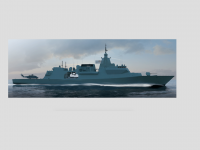Lockheed Martin, BAE submit warship bid
Days before the bid submission deadline for the Canadian Surface Combatant request for proposals, Lockheed Martin Canada has announced it has teamed up with the UK-based BAE Systems to submit a proposal for Canada’s new fleet of warships.
The combined request for proposals is for an off-the-shelf ship design and combat systems integrator, and experts say the Lockheed Canada and BAE duo will be a powerhouse contender.
For the ship design, BAE Systems is offering its Type 26 Global Combat Ship — long rumoured to be a favourite of Royal Canadian Navy officials and arguably the newest and most advanced vessel of its kind in the world — and the only possible contender that has yet to actually be built. The Royal Navy is building six of their own Type 26 vessels.
For the combat systems, which is best described as the brain and nervous systems of the ship’s intelligence and combat operations, Lockheed Canada is offering its Canadian-designed CMS 330. This is a newer version of the combat management system Lockheed designed for the Royal Canadian Navy’s original Halifax-class ships and is present on Canada’s modernized frigates.
Both firms were identified among bidders prequalified to participate in the process, alongside other international industry giants like ThyssenKrupp, Navantia and DCNS.
Also part of the consortium participating in the Lockheed/BAE bid are CAE, L3 Technologies, MDA and Dartmouth-based marine tech firm Ultra Electronics.
Speaking with The Chronicle Herald on Monday, Gary Fudge, VP of Canadian naval systems programs with Lockheed, said an independent study completed by Lockheed Canada revealed the Type 26 as the best design in the running, and prompted their interest in teaming with BAE for preliminary work several years before Canada announced that it would be combining the ship design and combat systems integrator into a single bid.
He said BAE’s modern design and modern toolsets — for example their use of advanced digital blueprints that will make it easier to modify and modernize the design in the future — made the Type 26 the key contender for them.
“Given that Irving has just built the most modern shipyard, we wanted the designer to have toolsets and data that can migrate easily into Irving’s toolsets,” said Fudge.
Irving is the prime contractor for the combat portion of the government’s National Shipbuilding Strategy and will build a fleet of 15 Canadian Surface Combatants (CSCs) at its Halifax shipyard, with a budget of $56billion to $60 billion, starting in the 2020s. It will also have a say, alongside the federal government, in selecting the winning bidder.
Rosemary Chapdelaine, vice president and general manager with Lockheed Martin Canada Rotary and Mission Systems, on Monday touted job creation in Canada, including Nova Scotia, as a key component to their bid.
For example, Lockheed Canada’s combat systems and integration technology is built at a facility in Ottawa and tested at the the company’s Maritime Advanced Testing and Training Site in Dartmouth.
Chapdelaine said Lockheed Canada’s approach to the bid is to be seen as the Canadian team, even if it takes points from other parts of their bid.
“We want to provide the Canadian content, do the direct work in Canada using Canadian industry,” she said.
David Perry, a senior analyst with Canadian Global Affairs Institute, said Lockheed Canada’s long history with the Royal Canadian Navy via the Halifax-class frigates and the advantages of the Type 26 over other potential designs puts the consortium in a good spot in the competition.
“An advantage of the Type 26 would be that where the requirements for it overlap with CSC, the technology would be very new, without modifying the design at all. The other ships in the competition would be older technology, so they'd need to modify it to introduce more current technology,” he said.
But that doesn’t make it a shoo-in — in an RFP with thousands of different parts, Perry said the winning design will have to tick a lot of boxes.
Speed and accommodations for example, while adequate in the Type 26, Perry said are not necessarily the cream of the crop compared to other options out there.
Retired navy commander and defence analyst Ken Hansen agreed that Lockheed Canada’s extensive experience working with the Canadian Navy, as well as their edge on Canadian content, gives them an advantage over some parts of the competition.
But, he said, while extremely advanced technology, the Type 26 might not be the ship Canada needs due to its high price and extreme complexity.
“The (Type 26) is inordinately complex and it had a lot of teething pains — the ship has been described in the U.K. press as overpriced and a technical nightmare,” he said. “I have not gotten that warm feeling where the reassurances from the British design authorities say ‘Oh it’s solved and we’re back on track.’”
It is not known how many groups will submit bids for the CSC competition. At least one other has gone public — Alion Canada announced its bid with Dutch De Zeven Provinciën Air Defence and Command frigate as its design last week.
The federal government says it expects to be able to select a winning bidder at the earliest in the spring of 2018, dependent on the number and quality of bids it receives.


